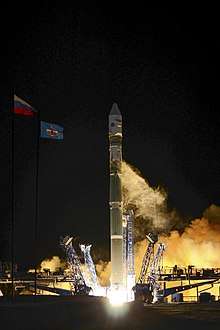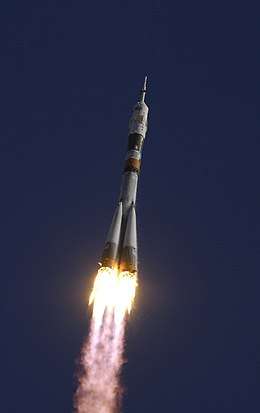Soyuz-2-1v
The Soyuz-2.1v (Russian: Союз 2.1в, Union 2.1v), GRAU index 14A15,[1] known earlier in development as the Soyuz-1 (Russian: Союз 1, Union 1), is a Russian expendable carrier rocket. It was derived from the Soyuz-2.1b, and is a member of the R-7 family of rockets. It is built by TsSKB Progress, at Samara in the Russian Federation. Launches are conducted from existing facilities at the Plesetsk Cosmodrome in Northwest Russia, with pads also available at the Baikonur Cosmodrome in Kazakhstan,[2] and new facilities at the Vostochny Cosmodrome in Eastern Russia.[3]
 Launch of an Soyuz-2.1v carrying Kosmos 2525 military satellite on 28 March 2018 | |
| Function | Light carrier rocket |
|---|---|
| Manufacturer | TsSKB Progress |
| Country of origin | Russia |
| Size | |
| Height | 44 metres (144 ft) |
| Diameter | 3 metres (9.8 ft) |
| Mass | 158,000 kilograms (348,000 lb) |
| Stages | 2 |
| Capacity | |
| Payload to 200km x 51.8° LEO | 2,850 kilograms (6,280 lb) |
| Payload to 200km x 62.8° LEO | 2,800 kilograms (6,200 lb) |
| Associated rockets | |
| Family | R-7/Soyuz/2 |
| Comparable | Long March 2C PSLV |
| Launch history | |
| Status | Active |
| Launch sites | Baikonur Sites 1/5 & 31/6 Plesetsk Site 43 Vostochny |
| Total launches | 6 |
| Successes | 5 |
| Partial failures | 1 |
| First flight | 28 December 2013 |
| Last flight | 25 November 2019 |
Vehicle
The Soyuz-2.1v represents a major departure from earlier Soyuz rockets. Unlike the Soyuz-2.1b upon which it is based, it does away with the four boosters used on all other R-7 vehicles. The first stage of the Soyuz-2.1v is a heavily modified derivative of the Soyuz-2 first stage, with a single-chamber NK-33 engine replacing the four-chamber RD-107 used on previous rockets along with structural modifications to the stage and lower tanking. Since the NK-33 is fixed, the RD-0110R engine is used to supply thrust vector control. It also supplies an extra 230.5 kilonewtons (51,800 lbf)[4] of thrust and heats the pressurization gases.[4]
The NK-33 engine, originally built for the N1 programme, offers increased performance over the RD-107; however, only a limited number of engines are available. Once the supply is exhausted, the NK-33 will be replaced by the RD-193. In April 2013, it was announced that the RD-193 engine had completed testing. The RD-193 is a lighter and shorter engine based on the Angara's RD-191, which is itself a derivative of the Zenit's RD-170.[5]
The second stage of the Soyuz-2.1v is the same as the third stage of the Soyuz-2.1b;[6] powered by an RD-0124 engine. For most missions a Volga upper stage will be used to manoeuvre the payload from an initial parking orbit to its final destination. The Volga is derived from the propulsion system of the Yantar reconnaissance satellite, and was developed as a lighter and cheaper alternative to the Fregat.
The Soyuz-2.1v was designed as a light-class carrier rocket, and has a payload capacity of 2,850 kilograms (6,280 lb) to a 200-kilometre (120 mi) circular low Earth orbit with an inclination of 56.8° from Baikonur, and 2,800 kilograms (6,200 lb) to a 200 kilometre orbit at 62.8° from Plesetsk.[2]
Operational history
In 2009, the maiden flight of the Soyuz-2.1v was announced as being scheduled for 2010, with this later being delayed to 2011 and then 2012 by development delays and payload availability. By June 2011 it was scheduled to occur at the end of 2012. During a test firing of a first stage prototype in August 2012, a test stand software malfunction resulted in damage to the stand and prototype, delaying the static testing programme.[7]
The test was re-attempted in May 2013, and was declared successful despite the burn lasting 52 seconds shorter than had been expected. With this complete, the launch was scheduled for September 2013. It subsequently slipped to November and then December.[8]
The maiden flight – which made use of a Volga upper stage – carried the Aist 1 microsatellite and a pair of SKRL-756 calibration spheres. Ahead of the launch, the rocket was rolled out to Site 43/4 at the Plesetsk Cosmodrome on 18 December 2013 with the launch scheduled for 23 December.[8]
The launch was delayed beyond 23 December by problems found during late testing at the pad. An attempt to launch was made on 25 December, but it was scrubbed around ten minutes before the liftoff, which had been scheduled for 14:00 UTC. Despite reports that the launch could not take place before the end of the year, it was rescheduled for 10:30 UTC on 28 December.[9] A further last-minute delay pushed the liftoff back to 12:30 UTC (16:30 local time), at which time the launch took place successfully.[10] Spacecraft separation occurred 100 minutes later, at 14:10 UTC.[11]
The second launch of the vehicle on December 5, 2015 carried two payloads Kanopus-ST and KYuA-1, while the Kanopus-ST failed to separate from the final stage.[12][13]
The third launch, which was an unannounced launch, carried a secret military payload on June 23, 2017 from Plesetsk.[14]
The fourth flight was on 29 March 2018 from the Plesetsk Cosmodrome. The booster orbited an EMKA satellite, which was reportedly designed to test miniature Earth imaging technology.[15]
The fifth flight took place on 10 July 2019 carrying four military satellites, Kosmos-2535, Kosmos-2536, Kosmos-2537 and Kosmos-2538, from the Plesetsk Cosmodrome.[16]
Flight number 6 took place on 25 November 2019 17:52 UTC from Plesetsk Site 43/4. It delivered the Kosmos 2542 satellite for Ministry of Defence to Low Earth orbit. The flight used a Volga upper stage. The flight was successful.[17]
Photogallery from Paris Air Show 2011
Russia exhibited a model of the Soyuz-2.1v during the 2011 Paris Air Show at Le Bourget.
- General view of the rocket
_Paris_Air_Show_2011_take3.jpg) Second stage view
Second stage view_Paris_Air_Show_2011_take2.jpg) Detailed view of the payload section
Detailed view of the payload section
See also
References
- "Rus/Souyz-2 launch vehicle" (in Russian). Plesetsk. Retrieved 30 December 2013.
- ""Soyuz-1" middle class launch vehicle". Samara Space Centre. Archived from the original on 19 April 2009. Retrieved 11 April 2009.
- Peslyak, Alexander (24 July 2013). "Vostochny Cosmodrome clears the way to deep space". Russia Beyond The Headlines. Retrieved 30 December 2013.
- "Steering engine RD0110R (14D24). Carrier rocket "Soyuz-2-1v"" (in Russian). KBKhA. Retrieved 1 June 2015.
- "New engine for light rocket "Soyuz" prepare for mass production at the end of the year" (in Russian). Новости космонавтики. Retrieved 8 April 2013.
- Zak, Anatoly. "Origin of the Soyuz-1 project". RussianSpaceWeb. Retrieved 30 December 2013.
- Zak, Anatoly. "Development of Soyuz-1". RussianSpaceWeb. Retrieved 28 December 2013.
- "Soyuz 2-1v". Spaceflight 101. Retrieved 28 December 2013.
- Zak, Anatoly. "Soyuz-2-1v lifts off successfully". RussianSpaceWeb. Retrieved 28 December 2013.
- "After Series of Delays, Russia Launches New Soyuz Rocket". RIA Novosti. 28 December 2013. Retrieved 28 December 2013.
- Nathaniel Downes and Chris Bergin. "Russia conducts debut launch of Soyuz-2-1v". NASASpaceflight.com. Retrieved 28 December 2013.
- Reuters Editorial. "PRESS DIGEST - RUSSIA - Dec 7". Reuters. Retrieved 10 December 2017.
- "Russian Soyuz-2.1v launch a partial failure". SpaceFlight Insider. Retrieved 10 December 2017.
- Clark, Stephen (23 June 2017). "Secret Russian satellite launched from Plesetsk Cosmodrome". Retrieved 24 June 2017.
- Zak, Anatoly (29 March 2018). "Soyuz-2-1v launches a military payload". Retrieved 29 March 2018.
- "Soyuz 2-1v conduts surprise military launch". Graham W. 10 July 2019. Retrieved 11 July 2019.
- Graham, William; Bergin, Chris (25 November 2019). "Soyuz 2-1v lofts mystery military satellite". NASASpaceFlight. Retrieved 25 November 2019.
